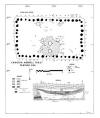

The Cahokia Pit House was started in 1982 and completed in 1983. It was sponsored by the Cahokia Mounds Museum Society and the layout and construction was under the direction of Dr. Errett Callahan of Lynchburg, VA. The finished report is nearing completion and should be available soon.
Dr. Callahan made a working model of the
structure before it's construction.
(The model can be seen to the left of the donation
box) By the way, this donation box was stolen in broad daylight while volunteers
were working. The Illinois State Police caught the suspect crossing Interstate
70, about 1 mile away. He had stashed the cash and was wearing different clothes
than those reported by the volunteers. When the troopers found the stash they
also found a second set of clothes that matched the ones seen by the volunteers.
He also made a Mill Creek hoe, a hafted celt, and a Ramey knife to be used specifically for the Cahokia Pit House Project.
 (Photo courtesy of Dr. John Kelly)
The plan view of the original structure (Feature # 306)
from the Merrell Tract excavations at Cahokia Mounds.
(Photo courtesy of Dr. John Kelly)
The plan view of the original structure (Feature # 306)
from the Merrell Tract excavations at Cahokia Mounds.
While Dr. Callahan lays out the location of the
interior post holes, the posts are being prepared.
The
cedar posts were donated by a Missouri man, then cut with stone axes or steel
axes. The bark was removed with stone axes and mussel shells. The posts cut with
steel were burned to remove any existing steel axe marks and to fire-harden the
wood.
The
pit had already been dug by Dr. Callahan and volunteers, using a Mill Creek
stone hoe fashioned by Dr. Callahan specifically for the Pit House project.
Posts were dug with digging sticks and clam shells.
While the Pit House framework was being constructed, volunteers started making fragmities mats to be used at the front entrance, while others gathered the large amounts of saplings needed for wattle.
While wattling was being carried out, other
volunteers began harvesting the several truckloads of Big Bluestem prarie grass
needed for the thatch. It was obtained from some Railroad property about 2 miles
West of Cahokia Mounds. Much of the thatch was cut with steel machetes but some
was cut with a Mill Creek hoe. After it was cut, the laborious task of cleaning
the thatch was undertaken.
The thatch was drawn between the fingers to remove excess material and leave
only the true prairie grass stems. The thatch was tied into convenient bundles
that could be hoisted to and handled by the thatchers, with more ease.
Once the thatch was prepared it was attached to the
roof structure with rawhide strips and/or baling twine.
Once the thatch was in place, the rawhide
windows/vents were fashioned. They were made to be opened to let air circulate
throughout the structure and to allow smoke to escape the structure.
After the thatch was applied, it was trimmed using a
Mill Creek Ramey knife fashioned by Dr. Callahan, for the project.
 (Photo courtesy of Dr. John Kelly)
The pit house after a light snow in 1983.
(Photo courtesy of Dr. John Kelly)
The pit house after a light snow in 1983.
About a year later, the
Cahokia Mounds Volunteers redesigned the roof.
Occasionally, the volunteers would drive out the
spiders and other insects by starting a small smoky fire in the house. Here, you
can see the smoke escaping through the thatch during a rainy morning. You can
also see, through the rawhide vent, the warm glow from the fire, on a
full-moon evening.
In 1983, a stockade was erected around the Pit House area to protect it and restrict continued vandalism, while still allowing public access to the area.
Continue to: The Cahokia Stockade